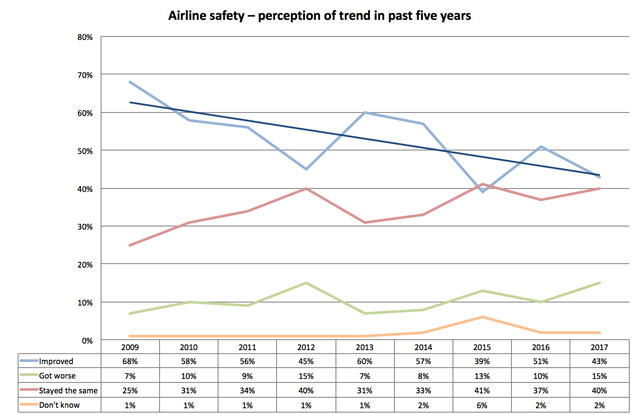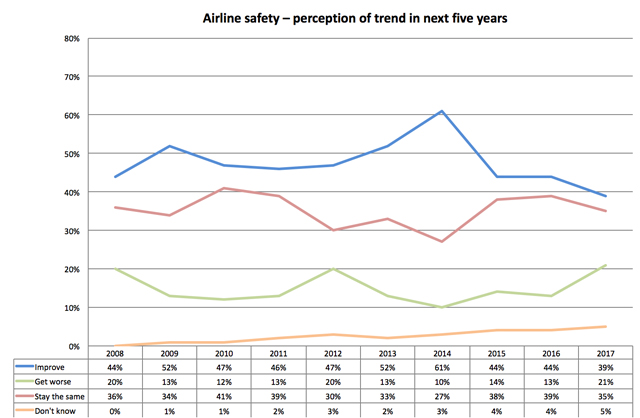Last year was yet another "safest year ever" for airlines, with a fatal accident rate of one per 4.83 million flights. There were so few passenger fatalities that the revenue passenger fatality rate, of one per 900 million passengers carried, becomes meaningless in isolation.
With so few accidents, annual numbers are of little value and a better guide might be the five-year moving average. The passenger fatality rate for the five years to the end of 2017 was one per 23.8 million carried.
Download FlightGlobal's Safety Perception Survey 2017 here
However, despite this well-established trend for increasing safety, Flight Ascend Consultancy's annual safety perception survey of people in the air transport sector reveals that the view of safety is far less sanguine. This can have positive consequences, as complacency – a belief that "things are good and we can all stop trying" – would almost certainly result in more accidents.

Source: Flight Ascend Consultancy safety perception survey
In our 2017 survey, a majority of respondents, 55%, thought there had been no improvement in safety or that safety had worsened over the previous five years. Only 43% thought that safety had improved. Looking forward, again, a majority – 56% – of respondents took the pessimistic view that safety cannot be expected to improve any further or may actually get worse. Only 39% think that safety will continue to improve.
This shows a considerable reduction in the level of confidence from the year before, when 51% thought it had got better. But this is still an improvement over the 2015 survey, when just 39% of respondents thought things had got safer. However, although confidence levels demonstrated by our 2017 survey may not have been the lowest, they still fall a long way below those for 2009, the first year in which the survey was conducted, when 68% of respondents thought safety had improved.
There has been a trend of reducing confidence in the industry’s record of improving safety. Over the past 10 years the percentage of respondents believing things have been getting better has fallen by some 20 percentage points.
Looking to the future, when asked about changes in air safety during the next five years, respondents were even less confident, with just 39% believing that things will improve. This is the most pessimistic response ever to the survey.
In 2017, 35% thought safety would stay the same and 21% that it would get worse. In 2016, 39% of respondents thought there would be no change in safety while 13% thought it would get worse.

Source: Flight Ascend Consultancy safety perception survey
Respondents’ view of the future has been broadly consistent over time – they have been persistently pessimistic about the ability of the airlines to continue to improve safety.
Provided with a list of 10 potential threats to safety, participants were asked what level of threat each one represented. Among those judged a "significant threat", 42% cited "fatigue/work practice"; 36% "complacency"; and 34% "a shortage of experienced personnel". These are the same three most "significant threats" as cited in our 2014, 2015 and 2016 surveys, although their order of importance has changed slightly. In 2014, "fatigue" was thought to be the most significant, as it was in 2017, but it was in third place in 2015 and 2016.
As in previous surveys, areas seen as less of a threat included "rapid growth", "congestion", "ageing aircraft" and "criminalisation". The perceived threat to safety posed by "ageing aircraft" has again come bottom, with only 31% of respondents considering it either a "significant" or "bigger" threat. The perceived importance of this "threat" has been decreasing in most recent years.
The factors that were expected to be most important in driving improvements in safety in the future were mainly "technical" with "new technology (ground)", "aircraft" and "safety equipment" all being thought to be "bigger" or "significant" drivers for safety. "Management accountability", which had slipped to second place in 2016 after being ranked as the most important driver in 2015, was back in first position again in 2017, with 44% of respondents deeming it to be a significant driver for safety.
Drivers considered less important included "improved ground infrastructure/aids" and, perhaps surprisingly in an increasingly bureaucratic world, "increased regulatory oversight" and "increased safety audits/operating bans".
Download FlightGlobal's Safety Perception Survey 2017 here
Source: Cirium Dashboard


























